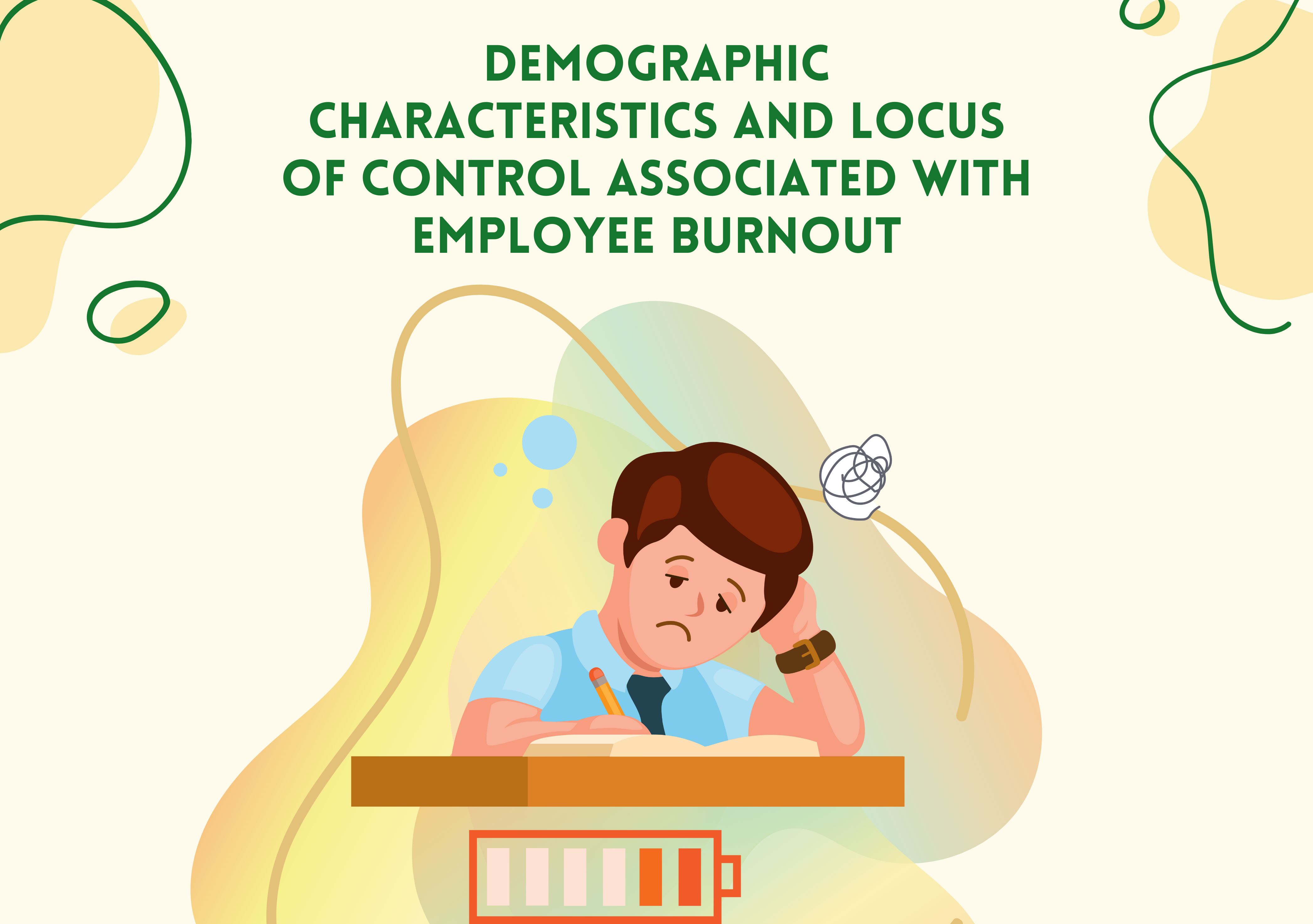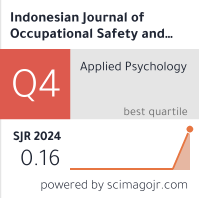Demographic Characteristics and Locus of Control Associated with Employee Burnout

Downloads
Introduction: Burnout in employees is caused by individual factors, including demographic characteristics and locus of control. This study aimed to analyze the relationship between demographic characteristics and locus of control with burnout among employees at the head office of a pharmaceutical company in North Jakarta. Methods: This research was a correlational study with a cross-sectional design. The population in this research were permanent employees of the pharmaceutical company's head office in North Jakarta, amounting to 88 employees. The research sample was 47 employees, using the probability sampling method with the proportional stratified random sampling technique. The independent variables in this research were gender, age, education level, marital status, and locus of control. At the same time, the dependent variable in this research was burnout. Data collection used the Maslach Burnout Inventory (MBI) and Work Locus of Control (WLOC). The data in this study were analyzed by the Spearman Correlation test and the Cramer Correlation test. Results: Most of the employees were female, 26-35 years old, married, and have a college education level. Burnout was moderate in most of these employees. Demographic characteristics which had a relationship with burnout were age (p=0.012) and education level (p=0.014). Meanwhile, gender (p=0.373) and marital status (p=0.297) had no relationship with burnout. Locus of control and burnout also had a relationship (p=0.015). Conclusion: Gender and marital status had no relationship with employees burnout. However, age and education level had a relationship with employees burnout. There was also a relationship between locus of control and burnout.
Abramson, A. (2022) ‘Burnout and Stress are Everywhere', Monitor on Psychology, 53(1), pp. 72.
Alexander, Smet, L. and Ravid. (2021) What employees are saying about the future of remote work. New York: McKinsey Global Publishing.
Amir, T. S. and Arshad, Z. (2021) ‘Locus of Control As a Mediating Factor on the Relationship Between Burnout and Self-Efficacy Among', Pakistan Journal of educational Research, 4(1), pp. 333–350.
Artz, B., Kaya, I. and Kaya, O. (2021) ‘Gender Role Perspectives and Job Burnout', Review of Economics of the Household, 20, pp. 447-470
Asante, E. A. and Affum-Osei, E. (2019) ‘Entrepreneurship as a Career Choice: The Impact of Locus of Control on Aspiring Entrepreneurs' Opportunity Recognition', Journal of Business Research, 98 (May), pp. 227–235.
Bitsadze, M. and Japaridze, M. (2016) ‘Locus of Control in Georgian Teachers and Its Relation To Teacher Burnout', Problems of Management in the 21st Century, 11(1), pp. 8–15.
Çelik, Ä°. and Sarıçam, H. (2018) ‘The Relationships between Positive Thinking Skills, Academic Locus of Control and Grit in Adolescents', Universal Journal of Educational Research, 6(3), pp. 392–398.
D'Souza, J. B. (2017) ‘The Influence of Self-monitoring and Locus of Control on Burnout of Thai Employees', Silpakorn University Journal of Social Sciences, Humanities, and Arts, 17(1), pp. 97–114.
Darmawan, A. A. Y. P., Silviandari, I. A. and Susilawati, I. R. (2015) ‘Hubungan Burnout dengan Work-Life Balance pada Dosen Wanita', Jurnal Psikologi Mediapsi, 1(1), pp. 28–39.
Darmilisani (2021) ‘Pengaruh Locus of Control Internal dan Locus of Control Eksternal terhadap Kepuasan Kerja pada Kantor Direksipt Socfin Indonesia Medan', Manajemen Tools, 13(1), pp. 1–14.
Fyana, L. and Rozali, Y. A. (2020) ‘Perbedaan Burnout Ditinjau Dari Jenis Kelamin', JCA Psikologi, 1(2), pp. 147–152.
Grobler, A. and Grobler, S. (2019) ‘Organisational Initiated Work-Life Balance Practises to Combat Burnout: The Mediating Effect of Work Locus of Control - Employing the Meso Paradigm Across Selected South African Public and Private Sector Organisations', African Journal of Hospitality, Tourism and Leisure, 8(5), pp. 1–15.
Indriasari, D. P. and Angreany (2019) ‘Pengaruh Locus of Control dan Beban Kerja terhadap Kinerja Pegawai Melalui Etos Kerja pada Badan Pendapatan Daerah Provinsi Sulawesi Selatan', Journal of Management, 2(3), pp. 1–19.
Ivancevich, J. M., Konopaske, R. and Matteson, M. T. (2013) Organizational, Behavior & Management, Tenth Edition. 10th edn, McGraw-Hill Publication. 10th edn. Singapore: McGraw-Hill Education.
Jiang, H. et al. (2021) ‘Factors Related to Job Burnout among Older Nurses in Guizhou Province, China', PeerJ, 9, pp. 1–16.
Kusumaningrum, I. Y. (2016) ‘Pengaruh Beban Kerja Dan Karakteristik Individu Terhadap Kinerja Perawat Melalui Burnout Sebagai Variabel Intervening Pada Pt. Nusantara Medika Utama Rumah Sakit Perkebunan (Jember Klinik)', Bisma Jurnal Bisnis dan Manajemen, 10(3), pp. 329–342.
Liana, Y. (2020) ‘Analisis Faktor Yang Berhubungan Dengan Burnout (Kejenuhan Kerja) Pada Perawat', Proceeding Seminar Nasional Keperawatan, 6(1), p. 108.
Llorent, V. J. and Ruiz-Calzado, I. (2016) ‘Burnout and its Relation to Sociodemographic Variables among Education Professionals Working with People with Disabilities in Córdoba (Spain)', Ciencia e Saude Coletiva, 21(10), pp. 3287–3295.
Marchand, A., Blanc, M. E. and Beauregard, N. (2018) ‘Do Age and Gender Contribute to Workers' Burnout Symptoms?', Occupational Medicine, 68(6), pp. 405–411.
Masduki, M. P., Ekawati and Wahyuni, I. (2021) ‘Hubungan Antara Karakteristik Demografi Pekerja, Beban Kerja Mental, dan Gaya Kepemimpinan Terhadap Burnout Pada Staff Administrasi FKM Undip', Jurnal Kesehatan Masyarakat (Undip), 9(6), pp. 784–792.
Maslach, C. and Jackson, S. E. (1981) ‘The Measurement of Experienced Burnout', Journal of Organizational Behavior, 2(2), pp. 99–113.
Maslach, C. and Leiter, M. P. (2016) ‘Understanding the Burnout Experience: Recent Research and its Implications for Psychiatry', World Psychiatry, 15(2), pp. 103–111.
Maslach, C. and Leiter, M. P. (2017) ‘Understanding Burnout', The Handbook of Stress and Health, pp. 36–56.
Maslach, C., Schaufeli, W. B. and Leiter, M. P. (2001) ‘Job burnout', Annual Review of Psychology, 52, pp. 397–422.
Mehrtak, M., Mahdavi, A. and Valizadeh, S. (2018) ‘Relationship between Locus of Control and Burnout among Health Information Technology Staffs at University Hospitals in Ardabil', Journal of Health, 9(4), pp. 414–422.
Priansa, D. J. (2017) Manajemen Kinerja Kepegawaian. Bandung: CV Pustaka Setia.
Putri, N. I. and Indrawati, E. S. (2020) ‘Hubungan antara Efikasi Kerja dengan Burnout Pada Perawat Bagian Jiwa Di RSJ Prof. Dr. Soerojo Magelang', Jurnal Empati, 8(3), pp. 1–6.
Putriana, D. (2019) Hubungan Antara Rasa Bersyukur dengan Burnout pada Perawat RSUD DR. Moewardi. Undergraduate Thesis. Surakarta: Faculty of Psycology, Universitas Muhammadiyah Surakarta.
Reynolds, B. W. (2021) FlexJobs, Mental Health America Survey: Mental Health in the Workplace.
Riyanto, S. and Hatmawan, A. A. (2020) Metode Riset Penelitian Kuantitatif Penelitian Di Bidang Manajemen, Teknik, Pendidikan Dan Eksperimen. Yogyakarta: Deepublish
Samodro, E. (2018) Hubungan antara Stres Kerja dengan Burnout pada Karyawan bagian Produksi. Undergraduate Thesis. Surabaya: Faculty of Psicology, Universitas 17 Agustus 1945.
Siagian, S. P. (2019) Manajemen Sumber Daya Manusia. 1st edn. Jakarta: Bumi Aksara.
Soelton, M. and Hardianti, D. (2020) ‘Factors Affecting Burnout in Manufacturing Industries', Advances in Economics, Business and Management Research, 120(Icmeb 2019), pp. 46–52.
Spector, P. E. (1988) ‘Development of the Work Locus of Control', Journal of Occupational Psychology, 61(4), pp. 335–340.
Suar, D. and Gochhayat, J. (2016) ‘Influence of Biological Sex and Gender Roles on Ethicality', Journal of Business Ethics, 134(2), pp. 199–208.
Swasti, K. G., Ekowati, W. and Rahmawati, E. (2017) ‘Faktor-Faktor Yang Mempengaruhi Burnout Pada Wanita', Jurnal Keperawatan Soedirman (The Soedirman Journal of Nursing), 12(3), pp. 190–198.
Wardani, L. M. I. and Firmansyah, R. (2021) Work-Life Balance Para Pekerja Buruh. Pekalongan: Penerbit NEM.
Widjaja, M. S., Sitorus, K. S. and Himawan, K. K. (2016) ‘Hubungan antara Kecerdasan Emosional dengan Kecenderungan Burnout pada Karyawan bagian Pemasaran', Jurnal Psikologi Ulayat, 3(1), pp. 18–33.
Wilski, M., Chmielewski, B. and Tomczak, M. (2015) ‘Work Locus of Control and Burnout in Polish Physiotherapists: The Mediating Effect of Coping Styles', International Journal of Occupational Medicine and Environmental Health, 28(5), pp. 875–889.
Yuwono, H. et al. (2020) ‘The Effect of Locus of Control on Employees' Job Satisfaction', Systematic Reviews in Pharmacy, 11(8), pp. 43–50.
Copyright (c) 2023 The Indonesian Journal Of Occupational Safety and Health

This work is licensed under a Creative Commons Attribution-NonCommercial-ShareAlike 4.0 International License.

In order to be accepted and published by The Indonesian Journal of Occupational Safety and Health, Author(s) who submit an article should complete all the review process. The copyright of received articles assigned to the The Indonesian Journal of Occupational Safety and Health and Department of Safety and Health, Universitas Airlangga as publishers of the journal. The intended copyright includes the rights to publish articles in various forms (including reprints).
The Editorial Team of The Indonesian Journal Of Occupational Safety and Health and Department of Safety and Health strive to ensure that no errors occur in the articles that have been published, both data errors and statements in the article.
Users of this website will be licensed to use materials from this website following the Creative Commons Attribution-NonCommercial-ShareAlike 4.0 International License. No fees charged. Please use the materials accordingly.
------------------------------------------------------------------------------------------------------------------------------------------------------------------------------------------
Attribution ” You must give appropriate credit, provide a link to the license, and indicate if changes were made. You may do so in any reasonable manner, but not in any way that suggests the licensor endorses you or your use.
NonCommercial ” You may not use the material for commercial purposes.
ShareAlike ” If you remix, transform, or build upon the material, you must distribute your contributions under the same license as the original.







 How to Submit Articles in OJS
How to Submit Articles in OJS

























